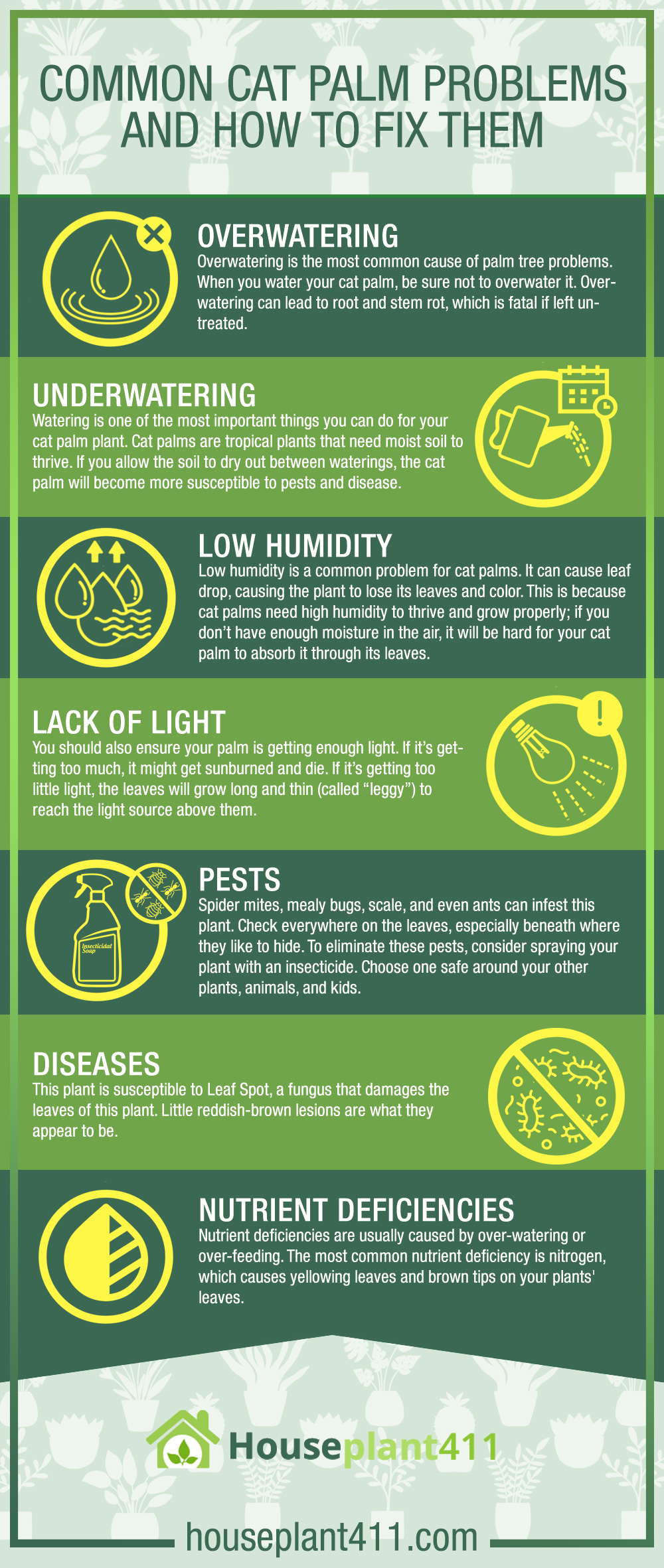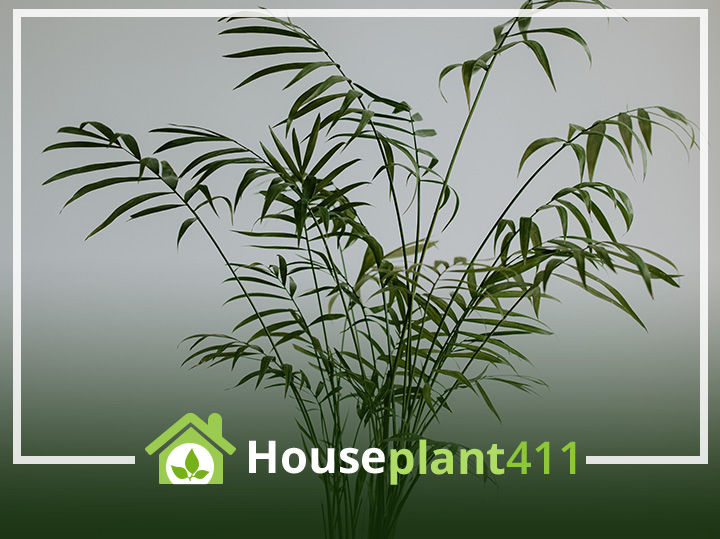Popular indoor plants like cat palms, also known as Chamaedorea cataractarum, require little maintenance. However, like any plant, it can still experience problems affecting its health and appearance if you don’t provide the right environment.
Here’s what you need to know about common palm problems and how to prevent them:
Overwatering
Overwatering is the most common cause of palm tree problems. When you water your cat palm, be sure not to overwater it. Overwatering can lead to root and stem rot, which is fatal if left untreated. Symptoms of root rot include leaf drop, yellowing, and browning around the edges of leaves on your cat palm tree; if you see these symptoms on one or more branches, then it’s time for some preventative measures!
Here are some tips to prevent overwatering in Cat Palm plants:
- Check the soil moisture: Before watering your Cat Palm, insert your finger about an inch deep into the soil. If the soil feels moist, do not water the plant. Only water the plant when the top inch of the soil feels dry.
- Use well-draining soil: Ensure your Cat Palm is planted in well-draining soil to prevent water from accumulating in the pot. The soil should mix peat moss, perlite, and sand or vermiculite.
- Use a pot with drainage holes: Use a pot with drainage holes to allow excess water to drain out of the pot. This will prevent water from accumulating in the pot, causing the roots to rot.
- Water the plant slowly: When watering your Cat Palm, water the plant slowly to allow the soil to absorb the water evenly. Avoid pouring water directly onto the plant, which can wash away soil and damage the leaves.
- Use a moisture meter: Consider using a moisture meter to check the soil moisture level in your Cat Palm’s pot. This can help you determine when it’s time to water the plant.
- Adjust watering frequency: Adjust the watering frequency based on the plant’s needs. Cat Palms need to be watered less frequently during the winter months when they are dormant and more frequently during the growing season in the spring and summer.
Underwatering
Watering is one of the most important things you can do for your cat palm plant. Cat palms are tropical plants that need moist soil to thrive. If you allow the soil to dry out between waterings, the cat palm will become more susceptible to pests and disease. Cat palms should be watered thoroughly once a week during the growing season and twice a week during winters when temperatures drop below 50 degrees Fahrenheit (10 degrees Celsius).
If you want to know exactly how often to water your cat palm plant, dig down into the soil with your finger until it’s damp, about 2 inches (5 cm) below the surface. If it feels dry down there after watering, wait another week before watering again.!
Here are some tips to prevent underwatering in Cat Palm plants:
- Check the soil moisture: Check the soil moisture regularly by inserting your finger about an inch deep into the soil. If the soil feels dry, it’s time to water the plant. Avoid waiting too long to water the plant, as this can lead to dehydration and damage to the leaves.
- Water thoroughly: Water your Cat Palm thoroughly to ensure it reaches the roots. Water until water starts to drain out of the bottom of the pot. This will help ensure that the soil is evenly moist.
- Use a watering schedule: Develop a watering schedule for your Cat Palm based on its needs. In general, Cat Palms should be watered once a week during the growing season and every two weeks during the winter months when they are dormant.
- Use room-temperature water: Use room-temperature water to water your Cat Palm. Cold water can shock the roots, while hot water can damage the leaves.
- Avoid using hard water: Avoid using hard water to water your Cat Palm, as the minerals in hard water can accumulate in the soil and cause damage to the plant. Use filtered or distilled water instead.
- Increase humidity: Cat Palms prefer high humidity, so consider increasing the humidity around the plant by misting the leaves with water or placing a humidifier near the plant.
Low Humidity
Low humidity is a common problem for cat palms. It can cause leaf drop, causing the plant to lose its leaves and color. This is because cat palms need high humidity to thrive and grow properly; if you don’t have enough moisture in the air, it will be hard for your cat palm to absorb it through its leaves.
If you notice that your plant doesn’t seem as healthy as usual or has been losing leaves regularly (more than 3 per week), chances are good that there isn’t enough moisture in your home’s environment. To remedy this issue:
- Increase the number of times per day when you water your plant by misting it with a spray bottle or using drip irrigation systems instead of letting them sit in standing water at all times (which could lead to them being overwatered).
- Place plants near windows where they get direct sunlight, but keep away from drafts coming through open windows since these will dry out air quickly around them too quickly, causing even more problems than just low humidity levels alone would cause!”
Lack Of Light
You should also ensure your palm is getting enough light. If it’s getting too much, it might get sunburned and die. If it’s getting too little light, the leaves will grow long and thin (called “leggy”) to reach the light source above them.
Cat Palms need bright, indirect light to thrive. If the plant is not getting enough light, the leaves may turn yellow and become leggy. Move the plant to a brighter location, but avoid direct sunlight, which can scorch the leaves.
Pests
Spider mites, mealy bugs, scale, and even ants can infest this plant. Check everywhere on the leaves, especially beneath where they like to hide. To eliminate these pests, consider spraying your plant with an insecticide. Choose one safe around your other plants, animals, and kids. Instead, you may use a child’s toothbrush to remove any scaling.
Diseases
This plant is susceptible to Leaf Spot, a fungus that damages the leaves of this plant. Little reddish-brown lesions are what they appear to be.
Nutrient Deficiencies
Nutrient deficiencies are usually caused by over-watering or over-feeding. The most common nutrient deficiency is nitrogen, which causes yellowing leaves and brown tips on your plants’ leaves. If you suspect your cat palm has a nutrient deficiency, there are several ways to fix it:
- Try giving the plant more water with fertilizer mixed in (but don’t give it too much). This should help restore its natural balance of nutrients and promote healthy growth again!
- Remove any dead or dying parts from the plant so that they don’t affect the rest of it later on down the road–you can do this by cutting off any dead/dying leaves at their base with scissors or pruning shears (never use sharp knives as they can cause damage).

Conclusion
With some basic care and attention, a cat palm plant will reward you with many years of vibrant, healthy growth that will bring character and visual appeal to your home or landscape. In the meantime, ensure the palms get the right amount of light, water, temperature, and humidity they need—and they’ll do the rest!

